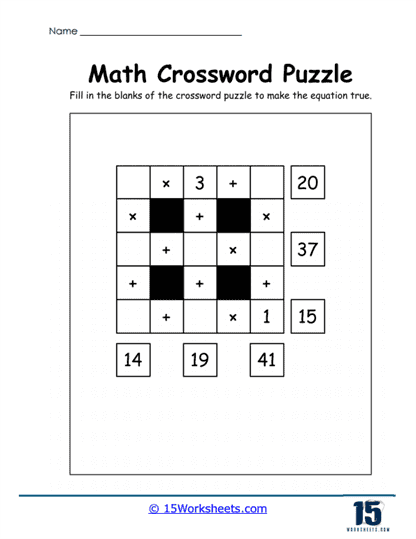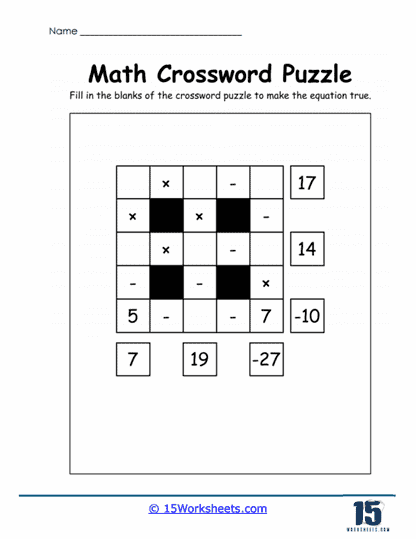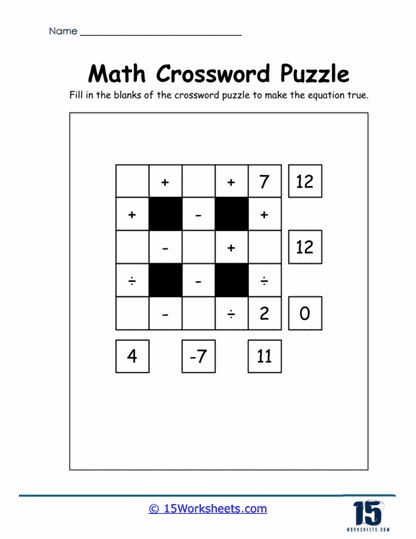Math Crossword Puzzles Worksheets
All About These 15 Worksheets
Cross number worksheets, often called number crosswords, are an innovative twist on traditional crossword puzzles that replace words with numbers. These worksheets are composed of grids filled with blank squares, where each square corresponds to a specific mathematical clue. The clues provided can span a broad range of topics, from basic arithmetic operations like addition, subtraction, multiplication, and division to more advanced concepts such as algebraic equations, fractions, or even geometry. The adaptability of these puzzles to various skill levels makes them a versatile tool for reinforcing mathematical knowledge and engaging learners of all ages.
What sets cross number worksheets apart is their ability to blend learning with entertainment. Unlike standard problem sets, these puzzles present mathematical challenges in a game-like format that stimulates curiosity and motivation. Solving a cross number puzzle requires not only computational accuracy but also logical reasoning to determine how each answer fits within the broader grid. This dual emphasis on calculation and strategy helps students build critical thinking skills, improve their number sense, and deepen their understanding of mathematical relationships. The interactive nature of these puzzles often encourages collaborative learning, as students may work together to solve challenging clues and complete the grid.
How Math Crossword Puzzle Worksheets Work
At the core of cross number worksheets lies their interconnected design, where solving one clue often directly influences the solution to another. For instance, if the horizontal answer to “3 across” is 12 + 7 = 19, the “1” from the number 19 becomes the starting digit for “5 down.” This interdependence creates a dynamic puzzle-solving experience where each solution acts as a building block for others, fostering a systematic approach to problem-solving. The requirement to cross-check answers not only reinforces accuracy but also encourages students to revisit and refine their work, cultivating persistence and analytical thinking.
Another engaging feature of cross number worksheets is the dual-directional nature of the clues, offering hints both across and down. This layout provides students with multiple entry points to tackle the puzzle, enabling them to strategically choose easier problems as a starting point and gradually work towards the more challenging ones. This interplay of flexibility and challenge makes the activity mentally stimulating, promoting critical reasoning as students navigate the puzzle. The grid’s structure mirrors real-life problem-solving scenarios, where the resolution of one issue often illuminates the path to solving others, making cross number worksheets an excellent tool for developing well-rounded mathematical proficiency.
A Look At The Individual Puzzles
1. Basic Arithmetic Heroics
Start your adventure with lighthearted champs like Math Match, Sum Puzzle, Add and Align, and Sum Solver. These are the friendly, early-game puzzles where students reinforce addition and subtraction fluency. Imagine aligning sums like puzzle pieces or matching number pairs as if Cupid himself shot arrows of arithmetic straight into their hearts. They’re thoughtful because students sense the rhythm of numbers-each plus and minus a step in their cognitive tap dance.
2. Multiplication & Maze Mayhem
Turn up the heat with Multiply Maze and Math Maze-the labyrinthine tests of multiplication prowess. Here students not only calculate but navigate winding paths of products, finding the route from entrance to exit. It’s like Indiana Jones with a times‑tables twist. These puzzles foster spatial reasoning and reinforcing multiplication under pressure, with each correct answer unlocking the next corridor. It’s maze-running meets math‑nerd glory.
3. Mixed Arithmetic & Exploratory Thinking
Now for the data‑rich zone: Mixed Match, Arithmetic Grid, Arithmetic Adventure (listed twice, but one is still always welcome), and Number Crunch. They combine addition, subtraction, multiplication (and sometimes division) in various formats-grids, match‑ups, treasure‑hunt adventures. The thoughtful twist: students treat numbers like explorers, crunching data, spotting patterns, and feeling that satisfying “aha” moment when all pieces fit. Plus, trying all those operations in one space is like doing a math dance marathon-which builds stamina and confidence!
4. Equation & Logic Explorers
Fancy yourself an Equation Explorer? Join Equation Explorer, Equation Fun, Puzzle Solver, and Number Navigator for mind‑bending journeys into algebraic wordplay and logical deduction. These are the meatier crew: deducing unknowns, balancing mini‑equations, and following clues like cryptic crossword detectives. So funny because they make students feel like secret agents cracking numeric codes-or perhaps as stage magicians levitating unknown variables into place.
5. Sum It All Up (Literally)
Arithmetic Adventure (yes, twice as fun!) stands under this summary umbrella, but also evokes every bit of the above: sum‑based pathfinding, mixed operations, equation‑style clues-all rolled into one epic saga. It’s like the grand finale where students apply every skill they’ve learned-with a grin-because they’ve traversed match‑ups, grids, mazes, and puzzles to arrive at the ultimate sum of their efforts. Deeply thoughtful, indeed: they’ve built fluency, pattern‑spotting, logical deduction, and the joy of figuring something out themselves.















